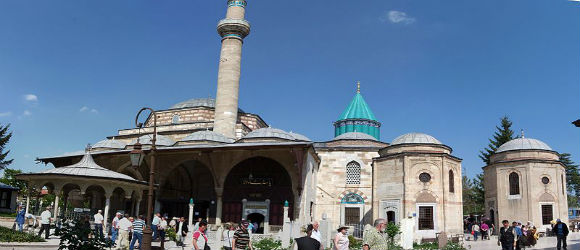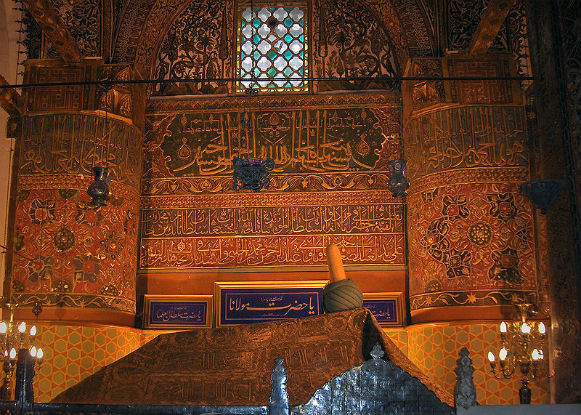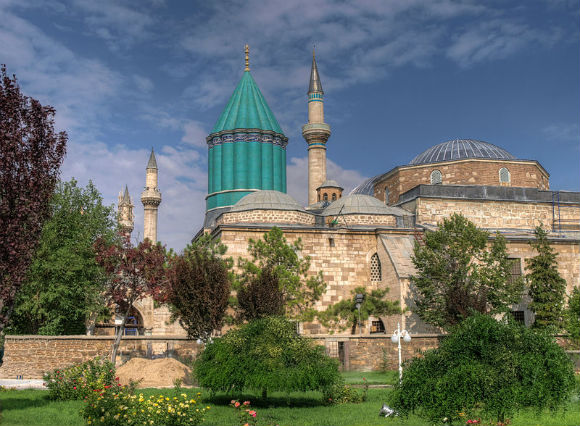The Mevlana Museum also known as the Green Mausoleum or Green Dome, is the original lodge of the Mevlevi Whirling Dervishes, a mystical Sufi Muslim group. It containes the tomb and shrine of the Mevlana, or Rumi, which remains an important place of pilgrimage.
History
Sultan ‘Ala’ al-Din Kayqubad, the Seljuk sultan who had invited Mevlana to Konya, offered his rose garden as a fitting place to bury Baha’ ud-Din Walad (or Bahaeddin Veled), the father of Mevlana, when he died in 1231. When Mevlana himself died on December 17, 1273, he was buried next to his father.
Mevlana’s successor Hüsamettin Çelebi built a mausoleum (Kubbe-i-Hadra) over the grave of his master. The Seljuk construction, under architect Behrettin Tebrizli, was finished in 1274. Gürcü Hatun, the wife of the Seljuk Emir Suleyman Pervane, and Emir Alameddin Kayser funded the construction.
The cylindrical drum of the of the dome originally rested on four pillars. The conical dome is covered with turquoise faience. Several sections were added until 1854. Selim I decorated the interior and performed the woodcarving of the catafalques.
A decree by Ataturk in September 1925 dissolved all Sufi brotherhoods in Turkey. On April 6, 1926, another decree ordered that the Mevlana mausoleum and dervish lodge be turned into a museum. The museum opened on March 2, 1927.
Special permission granted by the Turkish government in 1954 allowed the Mawlawi dervishes of Konya to perform their ritual dances for tourists for two weeks each year. Despite government opposition the order has continued to exist in Turkey as a religious body. The tomb of Rumi, although officially part of a museum, attracts a steady stream of pilgrims.
What to See
The dervish lodge (tekke) includes a semahane, where the ritual sema or whirling ceremony takes place, a sadirvan for ritual ablutions, a library, living and teaching quarters, and the mausoleum housing the tomb of Celaleddin Rumi, founder of the sect and later awarded the honorable title of Mevlana. His epitaph reads: “Do not seek our tombs on this earth – our tombs are in the hearts of the enlightened.”
The mausoleum room is highly ornamented with Islamic script and enameled reliefs, and contains the tombs of several of the more important figures of the dervish order. The main tomb enclosed behind a silver gate crafted in 1597 is that of Mevlana. The tomb of his father, Bahaeddin Veled, is upright and adjacent to his son’s, a position that signifies respect.
The adjoining room, or the semihane, is now a museum of Mevlana memorabilia displaying musical instruments and robes belonging to Mevlana, along with Selçuk and Ottoman objects like gold-engraved Korans from the 13th century. Among the fabulous ancient prayer rugs is the most valuable silk carpet in the world.
Mevlana Museum, Konya,




You have to pay for an audio guide.
But I recommend you to get one. It provided more information than I thought. I couldn't enjoy this museum and garden without the audio guide. They had Japanese version.
This is a very new museum and is in an old Mevlana meeting place. Its has better stuff in many ways than the better known one in Konya. Gaziantep was the second most important centre for the Mehlevis.
IT IS FREE. Loads of armed guards and a very nice collection of carpets and textiles. It is signposted from teh market.
If you are in Konya, Mevlana (pronounced Molana) Mausoleum is a must see. Mevlana Rumi was a Sufi master, a philosopher, a poet and religious leader of his time (http://en.wikipedia.org/wiki/Jalal_ad-Din_Muhammad_Rumi). Konya is a spiritual city for many Muslims who come and pay respect to Mevlana. Relative to Istanbul and Antalya, while Konya is a large city it is does not…
We very much enjoyed the museum and beautifully landscaped grounds with roses still blooming in late season. This is the birthplace of the whirling dervishes and the mystic, Mevlana, better known as Rumi. Their historical significance is well presented in the diarama tableaux of their lives. Inside are the tombs of Mevlana and other family members and lots of interesting…
If you haven't been able to see the Derwish to their magic before visiting the museum you might not get what it's all about.
I would recommend visitors to get the audio guides. It was packed full of information about the life of Rumi, Sufism and the buildings on the site. All of the sections of the museum and tomb also had their own distinct details, so all in all it ended up being a very insightful and enriching experience.
Gives a very interesting insight into Islam and completely blows the Catholic church away with it's easily-viewable historic artifacts
Konya is one of the first inhabited cities in the history of mankind, and is situated at 60 km north-west of an ancient civilization-The Neolithic site of Çatalhöyük. Because of its location in the middle of the Anatolian steppe, it used to be one of the most important trading centres on the Silk Road. It is one of the most…
Please read the articles in every corner carefully. Otherwise do not understand the philosophy. Everything has got it's own meaningful.
İet an strange place you could not dream it.not well known place in turkey by tourist but if you have enoug time expolre to turkey konya is the next stop